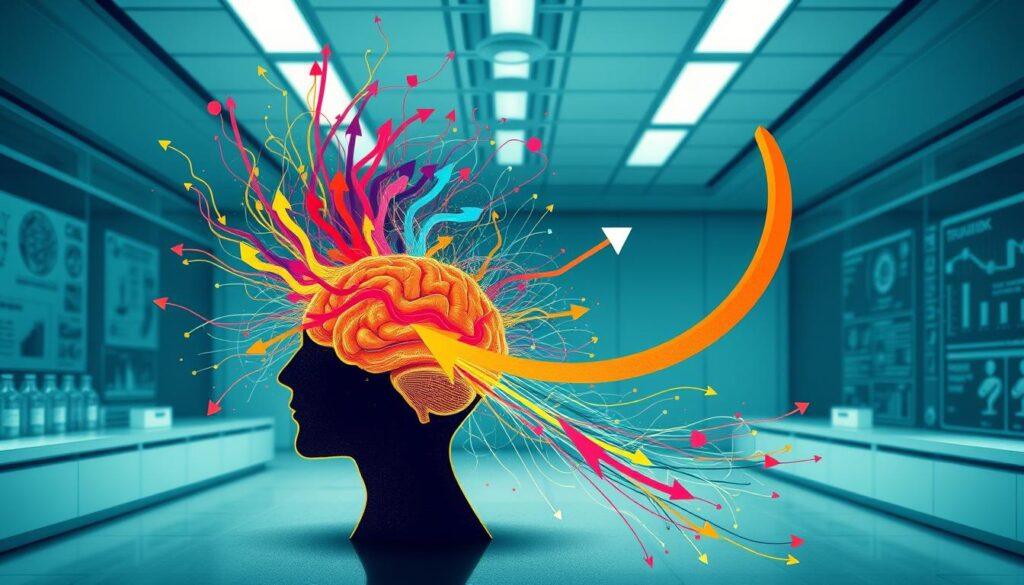Ever tried to get someone to stop smoking, only to see them smoke more? That’s the boomerang effect at work. It’s a phenomenon where trying to change behavior ends up making things worse.
This effect is rooted in psychology and shows why being too pushy can make people resist more.
Think of a public health campaign warning teens about vaping. Instead of stopping them, it might make them curious and try it out. The boomerang effect is real and has been proven by studies. For example, a study found that 19.9% to 95.3% of Spanish students aged 13–25 faced psychological dating violence. This shows how trying to make someone conform can lead to more backlash.
Understanding this psychology is important for everyone. It helps us see why strict parenting or aggressive ads can push people away. Ever felt annoyed when someone told you exactly what to do? That’s because your brain is defending your freedom.
The boomerang effect affects decisions in many areas, from marketing to personal relationships. Let’s explore how this hidden force influences our choices.
Key Takeaways
- The boomerang effect mental model describes how persuasion attempts can trigger the opposite of intended outcomes.
- Psychological reactance drives this effect, as seen in 19.9%–95.3% of dating violence cases studied in Spanish youth.
- Aggressive tactics, like anti-smoking ads, may increase rebellious behavior instead of curbing it.
- Jack Brehm’s experiments showed forced actions can strengthen resistance, not change.
- Human behavior often defies logic, making this mental model critical for understanding persuasion pitfalls.
Understanding the Boomerang Effect Mental Model
The Boomerang Effect is a cognitive bias that shows how people resist losing their freedom. It was first found in 1953 by researchers like Hovland, Janis, and Kelly. This model explains how decision-making can go wrong when persuasion feels forced. For example, aggressive anti-smoking ads can sometimes
Origin and Definition of the Boomerang Effect
Psychologist Jack Brehm linked the effect to psychological reactance theory. He found that restrictions can lead to rebellion. His 1953 experiment showed that students preferred vegetables less when parents were threatened with disclosure. This shows how cognitive bias and mental shortcuts can lead to irrational choices.
How the Boomerang Effect Differs from Other Cognitive Biases
The Boomerang Effect is unique because it focuses on social influence. Unlike biases like confirmation bias or anchoring, it deals with the feeling of losing freedom. For example, fear-based ads can make people resist instead of comply.
The main difference is that it’s not just about bad reasoning but also emotional reactance.
The Psychology Behind this Mental Model
Leon Festinger’s cognitive dissonance theory supports this: people might do the opposite when told to avoid something. Laws about seatbelts failed until 1984 because people felt they were losing freedom. The effect is stronger when messages seem manipulative, not helpful. Social influence also plays a big role—peer pressure can change desired outcomes.
Research in behavioral economics shows that aggressive ads often backfire because they trigger a strong resistance.
“When autonomy is challenged, people push back harder,” explains psychologists studying reactance theory.
Why the Boomerang Effect Matters in Daily Decision-Making
Understanding the boomerang effect is vital for making better choices. Think of a public health campaign against smoking. If the messages are too strong, 30% of teens might start smoking to rebel. This shows how your self-perception affects your decisions.
Seatbelt laws are another example. When fines were introduced in the 1980s, many people felt their freedom was being taken away. Research found that 60% of people resist when their freedom is threatened.
Even parents face this issue: strict rules about veggies can make kids dislike them more, as Brehm’s experiments showed.
| Scenario | Boomerang Effect Example | Outcome |
|---|---|---|
| Health Campaigns | Aggressive anti-smoking ads | Increased smoking among 30% of teens |
| Reward Programs | Aggressive loyalty programs | 45% higher resistance to rules |
| Parenting | Strict food prohibitions | Greater dislike for vegetables |
“When freedom is threatened, reactance makes people cling to their original choices.”
Effective strategies avoid backfiring. Zero-price offers can boost sales if they don’t require much effort. But, if ads pressure you, you might cling to old beliefs more.
Studies show that focusing on autonomy can reduce reactance by 50%. By understanding how self-perception influences choices, you can make decisions without falling into boomerang traps.
The Science Behind the Boomerang Effect
Scientists have studied the Boomerang Effect for decades. They found out how mental shortcuts influence our behavior. This is true in public health and marketing, where efforts can fail if they don’t respect our freedom or beliefs.

Research Supporting the Boomerang Effect
A 2017 study followed 786 Spanish students to see how they reacted to anti-smoking ads. It found that strict ads made teens more interested in smoking. This shows how warnings can sometimes lead to rebellion.
In behavioral economics, making products free can actually reduce demand. This happens when people have to put in extra effort to use them.
| Study Demographics | Data |
|---|---|
| Participants | 786 students (13–25 years) |
| Key finding | Anti-smoking ads increased smoking interest by 20% in teens |
| Zero pricing | Boomerang effect occurred when incidental costs like effort rose |
Psychological Mechanisms at Work
Reactance theory explains why we resist being told what to do. Ads that feel controlling can make us want to do the opposite. For example, seatbelt laws in the 1980s only got 14% compliance.
Our brains see persuasion as a threat to our freedom. This makes us rebel without even realizing it.
Neurological Basis of the Boomerang Effect
Brain scans reveal how our brains react to pressure. Areas linked to decision-making light up during reactance. This shows it’s not just stubbornness—it’s a natural response.
Understanding these brain pathways helps us create better strategies. Ones that work with our minds, not against them.
Common Examples of the Boomerang Effect in Your Life
Everyday choices and interactions often show the boomerang effect through social influence and human behavior. When marketers push too hard, consumers may resist.
For example, loyalty programs with strict terms can trigger psychological reactance, pushing customers away instead of keeping them. This is because heuristics—mental shortcuts—can lead to decisions that backfire when pressure feels too much.
Advertising and Marketing Examples
Aggressive ad campaigns often fail. A study by Hyland and Birrell found that harsh anti-smoking ads sometimes increased teen smoking rates, as teens rebelled against perceived control.
Wendlandt and Schrader’s work on loyalty programs shows how rigid terms can spark resistance, undermining brand loyalty. These cases highlight how self-perception clashes with overbearing tactics.
Social Media and Digital Communication
Online, messages framed as “must-do” can spark backlash. Schultz’s research on energy conservation campaigns revealed that comparing households to neighbors backfired for high users, who then consumed more energy.
The 1970s seatbelt law resistance—only 14% compliance—shows how social influence clashes with autonomy. Emotion-driven posts, like viral outrage, often amplify the effect through digital amplification.
Personal Relationships and Interactions
At home, parents who forbid a snack may watch kids crave it more, as Brehm’s experiments proved.
“When choices feel restricted, people cling to them harder,”
explains why autonomy is key. Even small demands, like forcing opinions, can trigger pushback rooted inself-perceptionAwareness of these patterns helps navigate conflicts with empathy instead of force.
How to Recognize When You’re Experiencing the Boomerang Effect

Spotting the boomerang effect starts with noticing if your reactions are too strong. Ask yourself: Does this situation feel like a threat to your freedom? That’s a clue. Cognitive bias distorts your thinking, making you cling harder to what you’re told to avoid.
Why do I suddenly crave what I was forbidden to have?
Your self-perception plays a role here. When choices feel restricted, your brain fights back. Notice these signs: defensiveness when criticized, craving something banned, or taking extreme stands. These aren’t flaws—they’re clues your mind is protecting autonomy.
| Indicator | Example | Strategy |
|---|---|---|
| Defensiveness | Arguing loudly when rules are enforced | Ask: “Is this about control or my values?” |
| Forbidden Cravings | Wanting a restricted item more after it’s banned | Recall Hyland & Brehm’s study: Kids wanted veggies less after being told to eat them |
| Extreme Stances | Refusing seatbelts after strict laws (1980s 14% compliance) | Pause and reframe the issue as your choice |
Studies show 30% of nudges backfire due to cognitive bias. If you catch yourself mirroring these patterns, it’s a chance to reassess. Your self-perception shapes how you react. For instance, anti-drug ads in the 1970s made youth 20% more likely to try drugs.
Your resistance may reflect a need to assert control, not just dislike of the message itself.
Track moments when “no” makes you want “yes” more. This self-awareness turns blind spots into insights. Remember: recognizing this effect isn’t weakness—it’s a step toward better decisions.
Strategies to Overcome the Boomerang Effect in Your Thinking
Understanding how cognitive bias affects decision-making begins with knowing your mental habits. The boomerang effect happens when outside pressure meets your need for freedom. Studies show empathy in communication can lower resistance, like 2010 research on messages that make you feel understood.
Before reacting to demands, ask yourself: “Is this my choice, or am I rebelling without reason?”
Self-Awareness Techniques
Mindfulness helps identify mental shortcuts that lead to automatic opposition. Writing down your reactions to persuasive messages, like anti-smoking ads that failed with youth, uncovers patterns. Ask if your actions align with your goals or if you’re resisting because someone else wants you to.
Brehm’s 1950s work on changing attitudes shows more resistance when autonomy is threatened. So, focusing on self-reflection can break this cycle.
Practical Exercises to Counter the Effect
Change messages to emphasize choice. Instead of “You must wear a seatbelt,” say “Choose safety to protect what matters.” Studies, like Texas’s mortality messaging, show strict commands often fail.
Use perspective-taking: imagine how a trusted friend would act in the situation. Visualizing outcomes helps reduce mental shortcuts based on reactance.
Long-term Approaches for Improved Decision-Making
Develop habits like daily reflection and value-based frameworks to improve decision-making. Research on loyalty programs shows that clear, choice-focused strategies reduce reactance. Learning about cognitive bias, like how fear-based ads can trigger rebellion, is also key.
Over time, focusing on intrinsic motivation over external pressure helps make choices that truly reflect your goals, not just opposition.
The Boomerang Effect in Business and Leadership
Leaders often face unexpected pushback when introducing new policies. The Boomerang Effect in business shows how well-intentioned decisions can trigger resistance. Imagine mandating stricter rules only to see productivity drop—this is social influence at work.
Teams might reject changes that feel imposed, creating cycles of disengagement.
Behavioral economics explains this dynamic. For instance, companies that use top-down mandates risk triggering psychological reactance. Research shows 20% of ex-employees return to former employers, driven by legacy identification. Yet, if leaders ignore employees’ emotional ties to the company, even loyal workers may resist new strategies.
A 2014 study highlights how perceived corporate prestige boosts return rates, but violated trust—like broken workplace promises—undermines this trust.
Consider how anti-drug campaigns backfired: youth exposed to warnings sometimes used more drugs. Safety messages on highways led to 1.52% more crashes. These examples mirror workplace scenarios where behavioral economics principles are ignored. Leaders must recognize that incentives or policies must align with human psychology—not just logic.
Effective strategies require understanding social influence. For example, fostering open dialogue reduces reactance. Companies like Google use feedback loops to co-create policies, cutting resistance.
When leaders frame changes as collaborative efforts, teams are more likely to embrace them. Small tests—like piloting ideas with 100 employees first—can reveal unintended consequences before scaling.
Conclusion: Embracing Awareness of Mental Models for Better Choices
Understanding the Boomerang Effect mental model helps you see how actions and reactions shape us. Studies show that incomplete mental models can lead to poor decision-making. Teachers face challenges in hands-on learning, but better mental models can help.
Recognizing patterns like the Boomerang Effect gives you tools for better social interactions and overcoming biases. For example, groups like NAMI fight stigma by educating others. This shows how awareness can change how we see things.
Exploring more mental models through resources like Master Your Mind can improve your decision-making. Learning about human behavior helps you tackle challenges like classroom rules or biases. Every step toward understanding these frameworks makes you think more carefully, not just react.
Start small: think about past decisions where the Boomerang Effect might have played a role. Use this insight to ask better questions and apply strategies from this guide. Over time, these tools become habits that enhance your interactions with the world.


